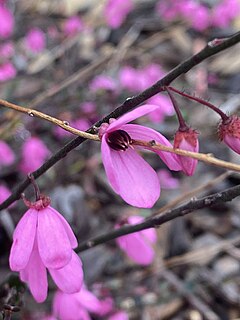
Nuytsia floribunda is a hemiparasitic tree found in Western Australia. The species is known locally as moodjar and, more recently, the Christmas tree or Western Australian Christmas tree. The display of intensely bright flowers during the austral summer coincides with the Christmas season.

Maireana sedifolia, also known as the bluebush or pearl bluebrush is a compact shrub endemic to Australia, and found in New South Wales, Victoria, South Australia, Western Australia, and the Northern Territory. It is used in pasture and as a garden plant where it is popular due to its distinctive grey foliage.

Hybanthus (green-violet) is a genus of flowering plants in the family Violaceae. This genus name is Greek for "humpback flower", referring to the drooping pedicels of plants that are part of this genus. The genus is grossly polyphyletic and may contain up to nine different genera, of which Pombalia Vand., Cubelium Raf. and Pigea DC. have been previously recognised.

The National Herbarium of Victoria is one of Australia's earliest herbaria and the oldest scientific institution in Victoria. Its 1.5 million specimens of preserved plants, fungi and algae—collectively known as the State Botanical Collection of Victoria—comprise the largest herbarium collection in Australia and Oceania.

The flora of Western Australia comprises 10,551 published native vascular plant species and a further 1,131 unpublished species. They occur within 1,543 genera from 211 families; there are also 1,317 naturalised alien or invasive plant species more commonly known as weeds. There are an estimated 150,000 cryptogam species or nonvascular plants which include lichens, and fungi although only 1,786 species have been published, with 948 algae and 672 lichen the majority.

Amyema quandang is a species of hemi-parasitic shrub which is widespread throughout the mainland of Australia, especially arid inland regions, sometimes referred to as the grey mistletoe.

Asteridea is a genus of flowering plants in the family Asteraceae. Evidence suggests that the genus, Asteridea, is monophyletic.

Hybanthus calycinus is a perennial herb of the violet family, Violaceae. The species is endemic to the south-west of Western Australia.

Tetratheca ciliata, commonly known as pink bells, is a small shrub in the family Elaeocarpaceae. It is endemic to southern Australia.

Nymphoides crenata, commonly known as wavy marshwort, is an aquatic perennial herb of the family Menyanthaceae endemic to Australia, found in all mainland states and the Northern Territory
Calotis cymbacantha, the showy burr daisy, is a species of Calotis native to the arid areas of Australia. It is a perennial herb that grows between 10 and 40 cm tall. It has hairy erect stems which are woody at the base and produces yellow flowers.

Scaevola collaris is a shrub in the family Goodeniaceae and its native range is five mainland states/territories of Australia: the Northern Territory, New South Wales, South Australia, Queensland and Western Australia.

Scaevola spinescens is a shrub in the family Goodeniaceae, found in all mainland Australian states and territories, in the drier parts.

Drosera finlaysoniana is a carnivorous herb found in Australia and south east Asia. More commonly found in the north of Australia. In southern Australian sites it has been recorded at inland areas, in eucalyptus woodlands subject to flooding. Also found in Hainan, Taiwan, the Indo-China region and the Philippines.

Podolepis canescens is a herb in the Asteraceae family, which is found in South Australia, the Northern Territory, New South Wales and Victoria. PlantNet also states that it is found in Western Australia, but FloraBase states that the name is misapplied in Western Australia, based on Jeanes (2015).

Asteridea chaetopoda is a species of herb in the Asteraceae family, which is endemic to Western Australia, in the south-west. It was first described in 1876 as Athrixia chaetopoda by Ferdinand von Mueller, and allocated to the genus, Asteridea, in 1980 by G. Kroner. It is a perennial herb, growing on sandy soils, on limestone and on gypsum, to heights from 5 cm to 30 cm. Its yellow flowers may seen from August to November on salt lakes, stony rises, and dunes of Beard's Eremaean and South-West Provinces.

Codonocarpus cotinifolius a tall shrub or tree in the Gyrostemonaceae family is a found in all mainland states of Australia, including Victoria, and is widespread in arid areas. It is suspected of being toxic to stock.

Westringia rigida is a shrub in the Lamiaceae family that is endemic to Australia. and

Macgregoria racemigera is a small plant in the family Celastraceae) found in inland Australia from New South Wales through Queensland, the Northern Territory to Western Australia, and South Australia.

Mirbelia floribunda, commonly known as purple mirbelia, is a species of flowering plant in the family Fabaceae and is endemic to the south-west of Western Australia. It is an erect, slender or straggling, much-branched shrub with narrowly linear leaves and bluish-purple flowers.



















